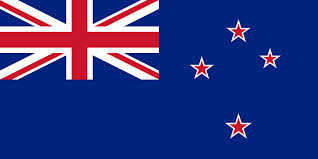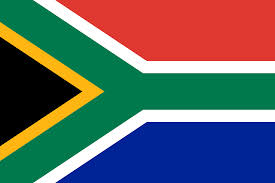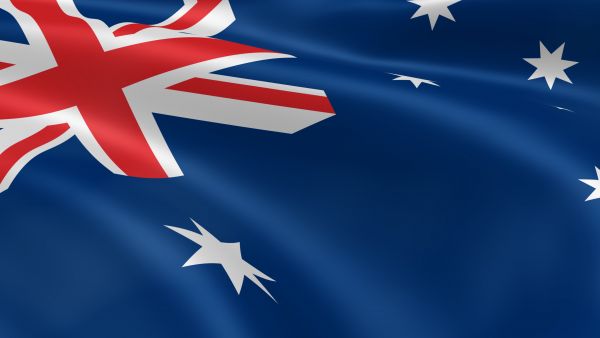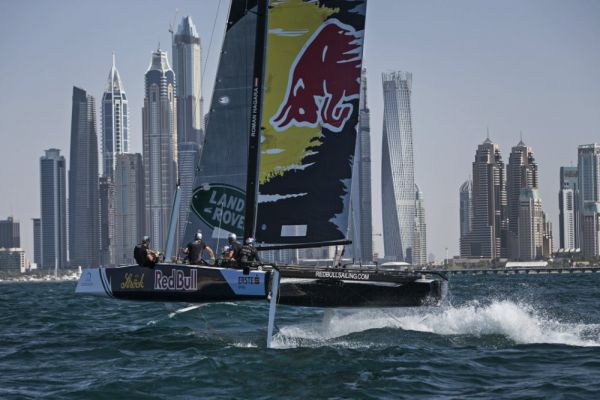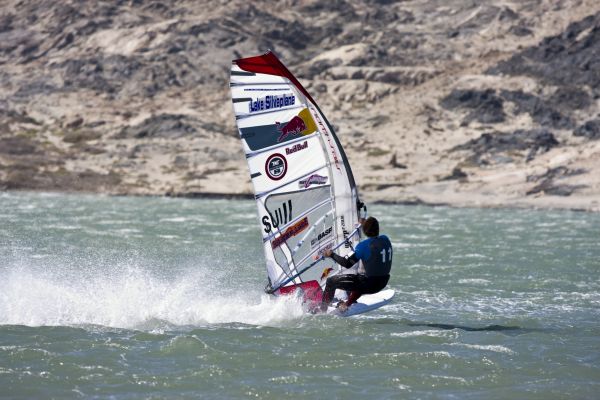After Red Bull Cape Fear was given the go-ahead for 2016, a selection of Australia’s best slab-riding specialists went to work on the biggest waves ever ridden at this infamous break. The paddle-in portion of the event was cancelled as it was deemed impossible to surf the waves without being towed-in by a jet ski.
The day saw plenty of thrills and spills as competitors pushed the limits in the 12-to-15 foot waves breaking only meters from a jagged rock shelf.
“I think everyone in the event would agree this is the biggest the Cape has ever been surfed,” said Maroubra’s Blake Thornton, a former world tour surfer and veteran competitor.
“I was really nervous before the event started, then once I got out on the back on the jet ski I was pumped up and ready to go. I didn’t want to wait too long before I got my first wave because I knew the nerves would build again, and thankfully managed to get a good one early.
“Even though I got absolutely smashed at the end of the battle it’s going to be a surf I remember for a long time, with one great wave and one of the worst wipeouts I’ve ever had.”
After two battles the event team re-assessed the conditions and confirmed the event would be postponed until Tuesday.
At the halfway mark of competition Justen Allport is leading with a score of 15.25, ahead of Russell Bierke and Evan Faulks in second and third respectively. Allport was taken to hospital for assessment after a wipeout at the end of his heat, but is in a stable condition.
The event team will assess conditions again on Tuesday morning. Further details on RedBullCapeFear.com.
Battle 1: Justen Allport, Jesse Polock, Blake Thortnon, James "Rooster" Adams
Battle 2: Riley Laing, Russell Bierke, Richie Vaculik, Evan Faulks
ABOUT RED BULL CAPE FEAR
COMPETITION FORMAT
• 16 surfers
• 8 head-to-head battles
• 4 surfers in the water at all times (2 contesting a 30-minute paddle-in element and 2 in a 30-minute tow-in element)
• Each battle crowns a winner, and the 4 highest placed winners will progress through to the final
• The highest placed surfer at the end of the final will be crowned the Red Bull Cape Fear Champion
TOW VS PADDLE SURFING
Paddle-in: The traditional act of using one’s arms while lying face down on a surfboard to propel the surfer forward and into the wave before attempting to stand-up. The slower-moving the wave is, the easier it is to paddle in to.
Tow-in: A little like wake-boarding, the surfer is given a tow rope attached to a jet-ski and pulled to his feet outside the breaking zone. The jet-ski operator, or tow-in partner, then tows the already-standing surfer at speed into the next wave where the surfer lets go of the rope and attempts to ride the wave. The quicker the wave the more speed the jet-ski requires to whip the rider in safely. The major benefit of the tow-in is it allows surfers to ride much bigger waves.
Red Bull Newsroom (Multi Sports)
Latest News & Results
| Professional big wave surfer Andrew Cotton risked his whole season to try and surf a giant wave off Ireland. Here the British athlete, who used to be a plumber and a lifeguard, explains how he travelled to the middle of the Atlantic Ocean in the winter 2015 looking for the next big swell. | |||||||||||||||||||||||
| Surfing plumber chases world’s biggest wave |
|||||||||||||||||||||||
| 27.07.2016 | |||||||||||||||||||||||
|
|||||||||||||||||||||||


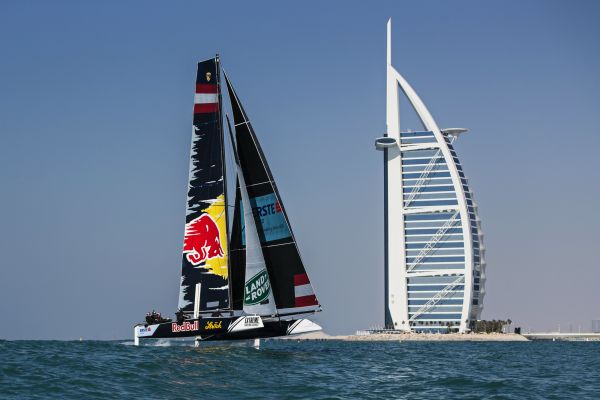 Double Olympic gold medalists launch new boat in front of Burj al Arab Double Olympic gold medalists launch new boat in front of Burj al Arab |
|
| Red Bull Sailing Flying on Foils in Dubai Double Olympic gold medalists launch new boat in front of Burj al Arab |
|
| 11.02.2016 | |
|

Hadlow defends prestigious Big Air kiteboarding title
Among the world’s best kiteboarders and with some 13,000 spectators looking on, a clinical Aaron Hadlow once again claimed the Red Bull King of the Air crown in Cape Town.
Cape Town (South Africa) – As Table Mountain’s ‘tablecloth’ cloud formations draped heavily over its slopes, it signified that the Southeaster was at its best at Big Bay for the Red Bull King of the Air final day with a 13,000-strong crowd glued to the action. In the closely contested final that saw extreme big air from Reno Romeu (BRA), Kevin Langeree (NED) and Jesse Richman (USA), it was defending champion Aaron Hadlow (GBR) who came out on top.
With the first round of the event having run earlier in the week, there were some clear standouts from the beginning – of which Romeu was one of them. He showed a lot of heart in the final, but was flagged-out first and it was left to the three previous champions to battle it out. Their contrasting styles showed throughout the day, but nowhere more so than when it was all on the line in the final: the technical Hadlow vs. the stylish and consistent Langeree vs Richman with his gung-hu, all-or-nothing approach.
Richman went big and flew far, but it was Hadlow, with his pinpoint execution who won the day over him, and Langeree rounded off the podium. Hadlow becomes the first rider to ever win the Red Bull King of the Air title for a second time.
The defending champion was really pumped on his win. “You can never expect how it’s going to go in the final and to be there with 2 past champions, I really had to go for it. I mixed it up, did some big kiteloops and landed my megaloop KGB which also helped me win last year.”
“The combination of the big waves with the strong wind made such a difference - it was an epic final. It’s insane to see how many people come down and how much energy the crowd gives you. There’s no better way to start the year than with this win,” said Hadlow.
Head judge Alex Vliege commented: “This was by far the closest final we’ve ever had at Red Bull King of the Air in Cape Town. It came down to the maths, taking into account each rider’s three best tricks and the event judging criteria. Each of them have totally different styles, but Aaron’s variation is what won him the title.”
Langeree took the competition’s ‘Mystic Best Move’ award with his kiteloop front roll, inverted one foot in the semi-final.


Polakow becomes the first windsurfer to ride Nazaré’s giant wave
It’s the big-wave mecca and it’s never been ridden by a wind-powered athlete – until this Tuesday, when Australia’s Jason Polakow windsurfed for the first time the liquid mountains of Praia do Norte, in Nazaré, Portugal.
Aged 44, the big wave windsurfer and two-time wave-sailing world champion found a new challenge: riding the 13m (43ft) waves of this infamous location on the Atlantic coast.
Polakow prepared for a year, studying and observing the Portuguese spot, finding the right support and safety crew before he felt ready to tackle some of the world’s biggest waves.
On Tuesday, February 2, 2016, the conditions were favourable, finally allowing him to windsurf it.
“It’s a very challenging and unique spot; no wave breaks in the same place and the height is very difficult to judge,” he said in a first statement after spending five hours in the water. “Chasing huge waves is my passion, so after seeing amazing images from big wave surfers, I just had to try.
“I’ve surfed all the big waves around the world and I must say that for me, Nazaré has been the most difficult and challenging. The waves are coming from many different angles at the same time, making it extremely difficult to judge and be safe. Water safety was my main concern, so having the two most experienced surfers – Andrew Cotton (UK) and Hugo Vau (POR) – taking care of me, and George Leal aka “Jesus” communicating with the water safety crew, I was feeling confident.
“The session we had was a great start for me in Nazaré, as I caught some huge waves. I’ve had a difficult but exciting adrenalized time out there and it’s for sure one of the highlights of my career!"
Polakow established himself as Australia’s top windsurfer at 18 years old. In 1990, he had already beaten windsurfing legend Robby Naish in his own backyard at the Maui World Cup Grand Slam. After two world titles, the wave-sailor broke away from full time competition. He’s been searching and windsurfing the world’s biggest waves for the past 10 years.
Sitting at the apex of a deep canyon that funnels the North Atlantic swell towards the shore, Nazaré attracts a few fearless big wave surfers every year. Waves can reach up to 100ft – that’s about 10-storey high. Polakow is the first ever wind-powered athlete to ride this iconic swell.
And the Australian has already set a new goal for himself. He aims at breaking the unofficial world record, which at the moment is around 60ft at the famous surfing location called “Jaws”, in Maui, Hawaii.
“For the longest time I thought “Jaws” was the epitome of big wave windsurfing but Nazaré definitely holds the key to producing the biggest waves in the world,” he added. “My goal is to come back here on a gigantic swell. We can definitely break that record right out here at Praia do Norte on the next big one.”
Q&A with Jason Polakow
When did you hear about Nazaré for the first time?
The very first time I heard about that spot was probably when Garrett McNamara had that world record wave. It was all over the news and right there I could see that there was potential to go windsurfing, because there was wind on the outside and Portugal has good wind. Right then, I sowed the seed in my head. It took quite a few years to get here, but I’m so happy that I came here and was able to do it.
Was it as difficult as expected?
Nazaré is such a unique spot. I’ve surfed all the big waves around the world and I must say that for me, Nazaré has been the most difficult and challenging. The waves are coming in from many different angles; from the south, from the southwest. They’re moving so much; it’s not like one spot where you can take off. It’s moving like 200 to 300 metres up and down the beach and you think you are in the right spot and you catch the wave and then all of a sudden the wave is gone; it’s super difficult. Particularly with the session I had out there, with the wind being so light I had to be very close to the inside and use a lot of jet-ski assistance. It was definitely the most difficult and exciting adrenalized time I’ve ever had.
What is it such a singular place?
Nazaré is a special spot. It has a very deep canyon that kind of comes into a V and the waves come from the outside down like a channel through this special cabin on the reef; then it hits the inside here and chucks up to a huge peak and causes the wave to sometimes quadruple in size. It’s just an amazing spot. One of the freaks of nature, for sure.
What did you think when you got there for the first time?
My first impression was like ‘wow, it’s going to be super difficult.’ I could see all the different swell directions coming and not really any spot to be in the right place. With the wind being so light, I knew it was going to be a real challenge.
How did you prepare for it?
Back in Hawaii I was doing a lot of swimming, cardio, breath-hold training; we had a lot of big swells this year, so I’ve just been out a lot of days and ‘practicing’ wipe-outs. Riding waves, getting wiped out, relaxing and keeping my heart rate down and doing as much practice as possible for Nazaré. Being in Hawaii has been a great training tool for this spot, but like I said, my first impression seeing this was pretty unexpected. I didn’t realize how difficult the wave is.
How many hours have you been in the water?
We had probably about five or six hours on the water, which is a pretty long time for being in the cold weather. The session we had was pretty good, some pretty huge sets. I wouldn’t say gigantic by any means, but for sure big enough to see where I was and get some experience on the spot and just building my confidence. Nazaré is not the place where you come and get 20 waves; it’s a place where you come and if you’re lucky you get one or two unbelievable waves for the day. Taking that into consideration I think I had about one or two good ones and I am happy with the result.
Why has never someone windsurfed Nazaré or even tried?
Windsurfing (or kitesurfing) Nazaré – no one has ever attempted to do that; I think there’s a couple of big reasons why. The first one is the danger element out there; it’s super gnarly when it gets big. Two is the logistics. The third thing is, there’s only maybe five or six guys who could possibly do this. That makes it very limited.
Why are you the only windsurfer to have tried this?
The main reason why I was fortunate enough to be the first to sail out here with wind is just having a good crew supporting me, some great local team as well and I guess just my own personal drive. I really, really wanted to do this. It’s a passion of mine to chase down the biggest waves. In windsurfing, we don’t make a huge amount of money, it’s just the drive and the passion that make us want to do it and that’s the goal for me.

FOUR-CROSS SLALOM LAUNCHES NEW ERA IN WINGSUIT RACING

CLOVERDALE (USA) – Streaking through an aerial slalom course above Northern California this weekend, Andy Farrington of the United States fought off a fierce challenge from an international field of 40 men and women from 18 countries to be crowned Red Bull Aces champion for the second consecutive year. The event takes the concept of snowboard cross to the skies as athletes jump four at a time from a helicopter at 8,000 feet/2,440 meters above sea level and fly – head-to-head – through a twisting course of five gates positioned at descending altitudes between 6,500 feet/1,980 meters and 3,500 feet/1,065 meters. Fellow American Noah Bahnson had a repeat second place in the competition that has launched a new age in wingsuit flying, while a newcomer to the Red Bull Aces podium, Matt Gerdes, completed the American sweep in third. Athletes from Norway, Sweden and Australia also clinched finishes in the top 8.
By the time the lineup of only the best athletes from five continents was narrowed down to the Final 4, the race was almost too close to call. Farrington and Bahnson were neck and neck through the 112-foot/34-meter long gates suspended by helicopters. Because both pilots passed through the gates with perfect accuracy, it all came down to time, and Farrington edged Bahnson by less than four-tenths of a second.
Combining speed, precision and agility, Red Bull Aces was developed to determine the world’s best all-around wingsuit pilot in a competitive environment that has inspired new training methods for the athletes as well as visionary designs for the suits, which enable swift and agile flight thanks to their ingenious construction.
“This is such a unique event, and a previous win doesn’t guarantee you anything against the talent here,” said Farrington, who has logged 24,000 jumps in his 33 years. “I raced Noah [Bahnson] three times today, and if the slightest thing had changed, he could have been at the top of the podium in a heartbeat. We’re going up against the top caliber of competitors in the world and the field is only getting stronger.“
About Red Bull Aces
The world’s first-ever wingsuit four-cross competition, as well as the first with air gates, Red Bull Aces was introduced in 2014 and returned in a new Northern California location this year with all the excitement of the pioneering 160-mph (260-kmh) race, plus improved technology besides. The goal of the contest – where athletes jump four at a time from a civilian Bell Huey helicopter to fly simultaneously through an aerial slalom course of five 112-foot/34-meter gates – is to find the world’s best all-around wingsuit pilot.
Final Ranking Red Bull Aces 2015: 1. Andy Farrington (USA), 2. Noah Bahnson (USA), 3. Matt Gerdes (USA), 4. Scott Palmer (USA) 5. Espen Fadnes (NOR), 6. Petter Mazzetta (SWE), 7. Rex Pemberton (AUS), 8. Scotty Bob (USA); 10. Tony Uragallo (GBR), 11. Pablo Hernandez (ESP), 12. Julian Boulle (SRA), 15. Carlos Briceno (VEN), 19. Sebastian Alvares (CHI), 20. Vincent Descols (FRA), 21. Gilaad Elstein (ISR), 22. Jason Moledzki (CAN), 26. Vincent Cajiga (MEX), 30. Tim HeHedderich (GER), 32. Roberta Mancino (ITA), 33. Michi Schwery (SUI)
Red Bull Aces Course Facts
Approximately 1 mile/1.6 kilometers in length, the Red Bull Aces slalom course for 2015 is created by five air gates suspended from helicopters. Made specifically for the race from the type of zero porosity fabric used in high-performance parachutes, the unique 112-foot-long/34-meter-long gates are printed through an exclusive process in New Zealand and assembled and counterweighted in the United States. On race day, the athletes jump four at a time from a civilian Bell Huey helicopter at an altitude of 8,000 feet/2,440 meters above sea level. The gates are positioned at descending levels between 6,500 feet/1,980 meters and 3,500 feet/1,065 meters. All the gates are equipped with GPS positioning, and the competitors each wear a GPS transmitter to determine whether they pass through the gates properly. Computer systems on the ground receive the information in real time, making the judging immediate. The winner is based not only on how quickly the finish line is crossed, but also on how many gates he/she correctly passes through. The athletes make a parachute landing back at the take-off area after finishing their run.

Ogier crash gifts Mikkelsen maiden win

Andreas Mikkelsen claimed his maiden WRC victory at Spain’s RallyRACC Catalunya - Costa Daurada on Sunday when world champion Sébastien Ogier crashed out of the lead in the final speed test.
In a hugely dramatic finale, Mikkelsen and co-driver Ola Floene finished the last stage and learned they had edged Volkswagen team-mate Jari-Matti Latvala for what should have been second after a fierce final day fight.
Seconds later the Norwegian was informed that Ogier had smashed his similar Polo R into a metal roadside barrier less than 4km from the finish, ripping the rear right wheel from the car.
Mikkelsen was stunned into silence as he realised the significance of his colleague’s error. It was his first WRC win in 64 attempts and kept alive his hopes of pipping Latvala for second in the drivers’ standings at next month’s final round in Britain.
“It was absurd because Ogier never makes mistakes so when they told me I didn’t believe it. It was a big surprise, and although it’s not the way I want to win a rally, we’ve been so close so many times that I feel I really deserve this one,” said 26-year-old Mikkelsen.
Ogier was airlifted to hospital but was passed fit after checks. The 31-year-old Frenchman was seemingly on his way to an eighth victory of the season on the four-day mixed surface event south of Barcelona with a comfortable 50.9sec lead over Mikkelsen.
Mikkelsen and Latvala fought tooth and nail through the final leg and were less than a second apart before Latvala punctured three stages from the end. Mikkelsen then spun in the penultimate test and the duo began the final stage showdown 1.4sec apart.
The eventual winning margin was 3.1sec, with Dani Sordo taking the final podium place at his home event in a Hyundai i20, a further 18.1sec back.
Citroen’s Mads Østberg finished fourth after demoting team-mate Kris Meeke who spun his DS 3. The gap between them was 1.9sec, with New Zealand’s Hayden Paddon completing the top six in another i20.
Thierry Neuville’s hopes of a top six finish ended in the penultimate stage when a transmission problem pitched the Belgian off the road under braking. He limped through the final stage to take eighth behind Martin Prokop’s Ford Fiesta RS. WRC 2 winner Pontus Tidemand and team-mate Jan Kopecký completed the leaderboard.
The final round of the season is the gravel Wales Rally GB which is based in Deeside on 12 - 15 November.

FMX legends get down in desert dunes as Red Bull X-Fighters invade Abu Dhabi
ABU DHABI (United Arab Emirates) Two Freestyle Motocross pioneers, Ronnie Renner and Drake McElroy of the United States, went on a jump- and trick-filled expedition of the world's largest contiguous sand desert to warm themselves up and Abu Dhabi up ahead of the fifth and final stop of the 2015 Red Bull X-Fighters World Tour in the capital city of the United Arab Emirates on Friday.
Renner, a superstar of the freestyle world and an Red Bull X-Fighters expert, took McElroy, an FMX pioneer and legend in his own right who is also one of the Red Bull X-Fighters judges, out into the Arabian Desert for a mind-boggling late afternoon ride into one of the world's most beautiful deserts with its spectacular dunes and amazing reddish sands.
The Rub' al Khali desert south of Abu Dhabi, which is part of the larger Arabian Desert surrounding it, is filled with imposing sand dunes of up to 250 meters high and spread out over an area that is 1,000 kilometers long and 500 kilometers wide.

France's Tom Pagès and Clinton Moore of Australia will face off in a fight to the finish on Friday in the closest showdown ever in the 15-year-history of Red Bull X-Fighters. The two have had a brilliant season in the sport, where the world's best FMX rider perform gravity-defying tricks off their bikes while flying 15 meters high and up to 30 meters in distance. Pagès and Moore are in a dead heat with 280 points each atop the World Tour standings.
WATCH IT LIVE: Red Bull X-Fighters Abu Dhabi, UAE will broadcast live on redbullxfighters.com and Red Bull TV at 8:00pm GST / 5:00pm CET on October 30. Red Bull TV is available on connected TVs, gaming consoles, mobile devices and more. For a full list of supported devices visit about.redbull.tv
 - All Sports
- All Sports






















